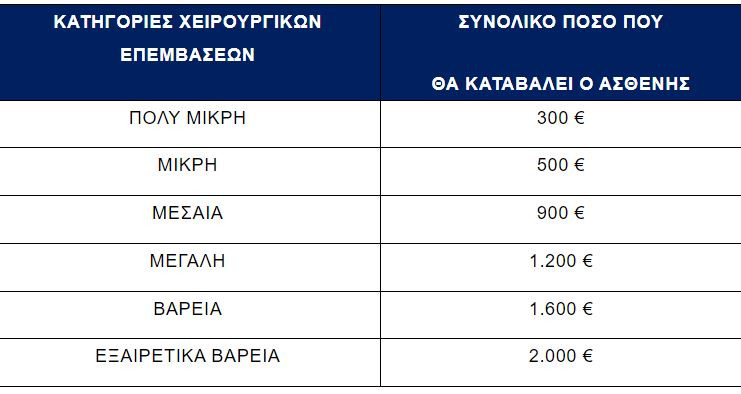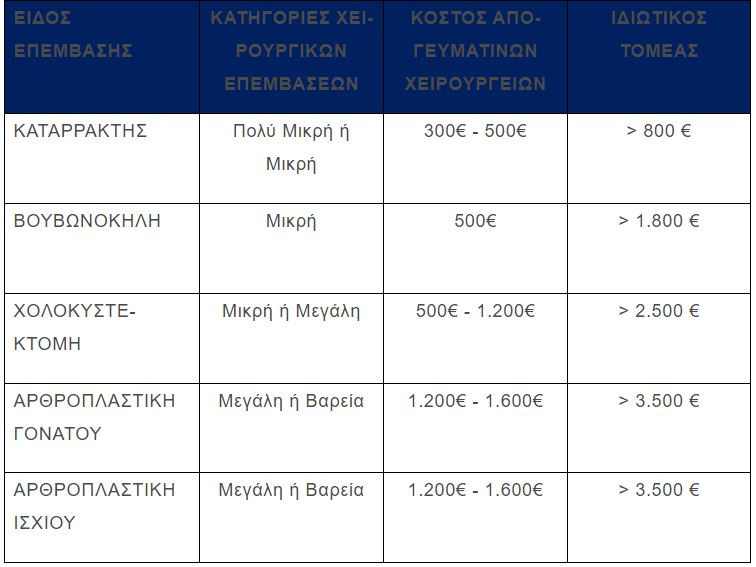What is up to date with public hospital operating room waiting lists – By December 103,000 patients were waiting to be operated on
The cost of operations ranges from 300 euros to 2,000 euros in the afternoon surgeries of public hospitals according to the plan of the Ministry of Health presented today in a press conference by the minister, Adonis Georgiadis, and the deputy minister, Marios Themistokleous.
See cost and wait breakdowns in the country’s surgery lists:
What is the current situation in our country regarding the waiting time of citizens for surgery?
The total number of citizens registered in the List of Surgeons in Greece, until the end of 2023, amounts to 102,000 citizens.
In 43% of cases, they wait less than 4 months for surgery. From 4 to 12 months, 31% of the total List waits, while 26% of patients wait for more than 12 months.
What is the geographic distribution for citizens waiting 4 to 12 months for surgery?
The total number of citizens waiting to be operated on for more than 4 and less than 12 months is 31,954. The distribution of cases in Greek territory follows the distribution below for a waiting period of 4 to 12 months.
- Northern Greece – 14,060 cases (44%)
- Attica and Aegean Islands – 11,183 cases (35%)
- Crete – 3,515 incidents (11%)
- Western Greece and Peloponnese – 2,557 cases (8%)
- Central Greece – 639 cases (2%)
What is the geographic distribution for citizens waiting more than 12 months for surgery?
The total number of citizens waiting to be operated on for more than 12 months is 26,221. The distribution of cases in the Greek territory follows the distribution below for a waiting period of more than 12 months.
- Northern Greece – 13,897 cases (53%)
- Attica and Aegean islands – 6,566 cases (25%)
- Crete – 4,447 cases (17%)
- Western Greece and Peloponnese – 1,049 cases (4%)
- Central Greece – 262 cases (1%)
Was analysis done to get the data? At what depth? Are there detailed hospital-level data as well?
In order to record and calculate the data, an extensive analysis was done up to the level of the hospital clinic, for all the country’s Hospitals that carry out surgical operations.
For example, in one of the large Hospitals of Athens (more than 400 beds), which receives a large volume of citizens for surgery, in the cardiac surgery clinic the waiting time for surgery is 4-12 months and 424 citizens are waiting.
In a Hospital of the same size in Thessaloniki, in the Orthopedic clinic, the waiting time is 4-12 months and there are 624 citizens waiting for surgery.
What is the solution to reduce the number of cases waiting to be operated on?
The Ministry of Health, with the aim of reducing waiting times for surgery, examined all possible options and the potential benefits for each of them. The solution that was selected and will be implemented immediately is the activation of the afternoon surgeries. In this way, more surgeries will be performed every day in order to serve as many citizens as possible. According to the study done, the capacity of the system with the afternoon surgeries is expected to increase by more than 20%.
What is the cost to the citizen, who will cover the costs of the afternoon surgeries?
For the performance of afternoon surgeries in the country’s Hospitals, funding has been secured from the Recovery and Resilience Fund in order not to burden the citizens financially.
More specifically, 60 million euros will be used by the Fund to serve citizens awaiting surgery. This funding is for surgery for people who remain on the Surgery List for a long time. Their prioritization will be done in chronological order (from oldest to newest), as reflected in the Unified List of Surgeries.
What are the most common types of surgery found on the Surgery Lists?
According to the analysis of the Ministry of Health, the main categories of intervention observed in Hospitals are shown in the table below. It is worth noting that over 50% of operations pending in the country are concentrated in the following 7 categories.
What will be the operating framework of the afternoon surgeries?
For the operation of the afternoon surgeries, the categorization of surgeries has been created, based on medical criteria. The specific categories of interventions also correspond to the corresponding costs that will arise from the performance of the specific interventions.
Costs that, as mentioned, will be covered by the funding of the Recovery and Resilience Fund.
In more detail, the categories of interventions and costs are presented in the table below:
Will evening surgeries cost less or more than equivalent surgeries in the Private Sector?
Based on the comparison of the prices between the types of operations that will be carried out during the afternoon surgeries with the corresponding types of operations at the Private Hospitals, a significant difference is observed between the costs of the operations.
In more detail, a comparison table is provided below:
What is the History of the Surgery List in our country, why does the Surgery List not work effectively?
Until 2017, there was no Surgery List in Greece, when it was instituted, with the aim of recording and monitoring citizens who need surgery. However, the operation of the Surgery List has not worked for 3 main reasons:
- Lack of standardized maintenance procedure
- Absence of continuous monitoring
- Absence of interconnection of the Surgery List with the rest of the Hospital’s procedures (e.g. performed surgeries)
What initiatives has the Ministry of Health taken?
To address both the delays and to improve the operation of the Surgery List, the Ministry of Health made strategic decisions.
The solutions were based on two pillars: The first pillar was based on ensuring the correct maintenance of the Surgery List and its continuous monitoring. The second pillar was based on the modernization of the operation of the Surgery List with its full digitization being a priority.
What were the initiatives for the management of the Surgery List?
One of the existing problems of the Surgery List, was the impossibility of clearing the List and therefore the unreliability of the data. Based on the instructions of the Ministry of Health, a committee was set up to clear the Surgery Lists. More than 150,000 calls were made to citizens in order to update the information on whether they wish to remain registered on the Surgery List.
The purge was an important step, as it appeared judging by the result, more than 38% of registered citizens did not wish to remain on the list for various reasons. The main reasons citizens did not wish to remain on the Surgery List were:
They chose to be operated either in other public Hospitals or in Private clinics to speed up the time
The citizen no longer wished to perform the surgery
Finally, to reduce the incidents, which are pending, a series of measures have been considered in accordance with the decisions of the Ministry of Health, which will begin to be implemented in the first months of 2024.
What reforms will happen to modernize the Surgery List?
To improve the functionality of the Surgery List, the Ministry of Health instituted the new Digitized Single Surgery List. The Legislative provision took place in September 2023 with the aim of standardizing and fully implementing the procedure. The operation of the Digitized Single Surgery List has started to operate as a pilot, with most of the country’s Hospitals having already joined it and within the next few weeks, it is expected that the Digitized Single Surgery List will be in full effect.
What is happening in the rest of Europe?
Surgery lists are kept in all European Health systems. The waiting time situation in European countries, regarding waiting times for surgical procedures in Hospitals, varies depending on the country. In some countries, such as Sweden, the waiting time for non-urgent surgery is 50 days on average.
In the United Kingdom, on the contrary, the situation is different, as the average waiting time of citizens for a non-urgent operation exceeds 12 months, according to the data of the country’s competent body. More specifically, the Surgery List has exceeded 7.6 million registrations in August 2023, a 37% increase compared to September 2021, when registrations were 5.6 million. Finally, it is worth noting that the number of citizens waiting for surgery for more than 4 months increased dramatically. More than 4 out of 10 citizens wait more than 4 months for surgery.
Are evening surgeries a temporary measure by the Ministry of Health?
The answer is no. Afternoon surgeries are planned and will be implemented with a view to being a permanent solution for the Health system. This specific initiative, together with the funding from the Recovery Fund, will be used as a tool to immediately reduce the waiting time of citizens on the surgery list, but the ultimate goal is to become a permanent possibility of the E.S.Y.
Source :Skai
I have worked in the news industry for over 10 years. I have a vast amount of experience in covering health news. I am also an author at News Bulletin 247. I am highly experienced and knowledgeable in this field. I am a hard worker and always deliver quality work. I am a reliable source of information and always provide accurate information.












